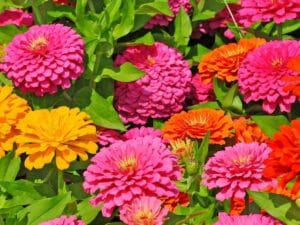Each year as the flower planting process begins, many homeowners ask themselves … what exactly is an annual? We here at Stone Creek Landscaping can definitely tell you what it is and how it differs from a perineal. Heck, we can even plant them for you! However we found a great blog all about annuals on the UGA Extension site. Below are some great exerts that we think will help you learn more about annuals and when to plant them.
Use
Flowering annuals have many uses in the landscape. They are most commonly found in beds and mixed borders. Tall annuals provide good backgrounds and quick screens. Annual vines can cover trellises, provide shade and soften harsh fencing. Some can be used as temporary ground covers. Many produce flowers good for cutting and drying. Several are also good for use in containers such as porch boxes, window boxes, hanging baskets and pots. Annuals can even be used around foundations, providing color and mass prior to the installation of permanent shrubs and ground covers. Few plants offer as much diversity in landscape use as annuals do.
Selection
Annuals vary considerably with respect to their environmental and cultural requirements. Some perform best in full sun while others do best in shade. Drought tolerance varies and planting times differ.
In addition to considering environmental and cultural requirements, carefully select annuals with respect to their intended use in the landscape. Height, spread, color range, time and length of color display vary considerably among annuals, sometimes even within a species. Certainly not all annuals will perform well under all conditions and for all uses.

Bed Preparation
Good bed preparation is essential for good performance of annuals. Because annuals have a relatively short time to grow and perform in the landscape, some preparations must be made for fast and sustainable growth.
Beds should be deeply spaded, to a depth of 8 to 10 inches if possible. Most annuals grow well in a variety of soil types as long as the soil is capable of holding a sufficient amount of water and the soil can drain. Heavy soils should have sand, perlite or coarse bark to improve drainage. To test for drainage, dig a hole about 10 inches deep and fill it with water. The next day fill the hole again and see how long the water remains in it; if it drains away in 8 to 10 hours or less, drainage is satisfactory for most annuals. In some situations, it may be necessary to install underground drainage lines or construct raised beds. Most of the annuals you see in commercial landscapes are in raised beds to ensure adequate drainage.
Care
Adequate moisture is essential to the growth of flowering annuals. Natural rainfall is sufficient at times of the year, but cannot be the sole source. Supplemental irrigation is often necessary, particularly during the summer months. Annuals vary in their drought tolerance, but as a rule most require at least 1 to 1 1/2 inches of water per week. More if there is extreme heat. Overhead sprinklers provide the least satisfactory method of watering; they must run for long periods in order to attain deep watering of the soil. Occasional sprinkling that only wets the upper inch or so of soil is undesirable. Wet foliage may also worsen foliar disease problems and compound problems with control. Drip or trickle irrigation is preferable.
